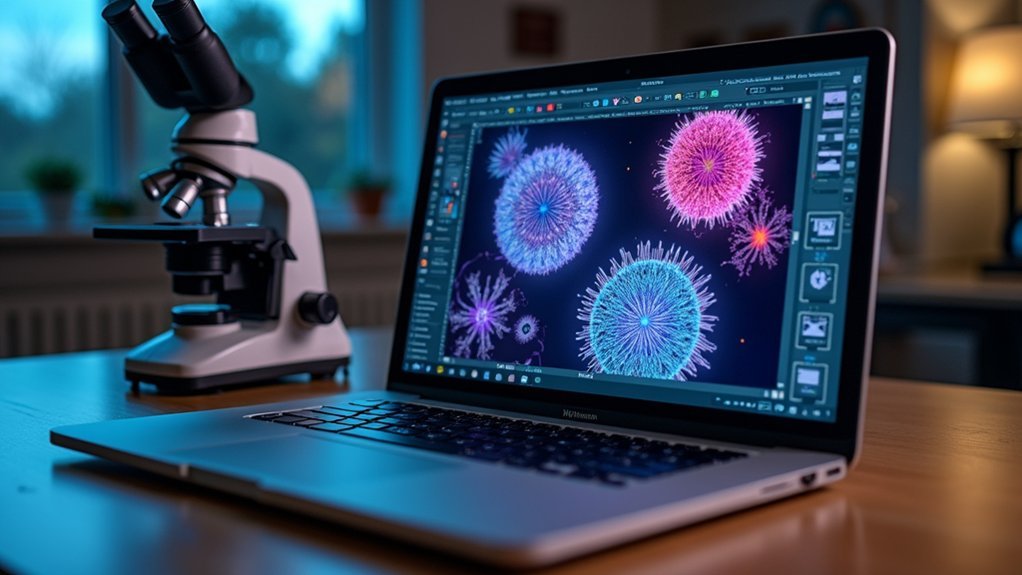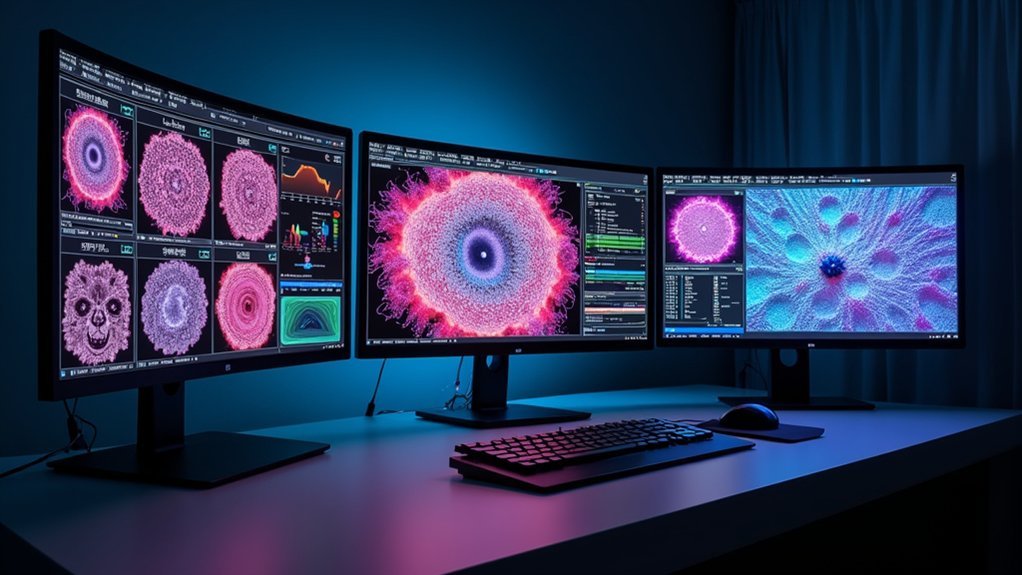When searching for budget microscope software, you’ll find excellent free options like ImageJ and Fiji offering powerful analysis tools, while commercial programs like AmScope ($50) and OMAX provide user-friendly interfaces for beginners. Don’t overlook mobile apps that transform your smartphone into a microscope display. The best budget solutions include exposure controls, measurement tools, and basic image enhancement features. Discover how these affordable alternatives can dramatically improve your microscopy experience.
Essential Features to Look for in Budget Microscope Software

When selecting microscope software that won’t break the bank, you’ll need to prioritize certain key capabilities over premium features.
Focus on programs that integrate smoothly with your microscope and camera, enabling efficient control to optimize image quality.
Look for software with a user-friendly interface that includes basic annotation tools for adding calibration data and image information.
A clean, intuitive interface with simple annotation capabilities transforms raw microscopic data into meaningful scientific documentation.
Verify it offers both automatic and manual exposure adjustments to handle various lighting conditions effectively.
Don’t overlook the importance of a thumbnail gallery for quick image review during your workflow.
Additionally, automatic calibration features that add scale bars are invaluable for accurate measurements.
These fundamental capabilities will serve your imaging needs while keeping costs manageable, striking the right balance between functionality and budget constraints.
Top Free and Open-Source Microscope Imaging Solutions
Despite budget constraints, you’ll find several powerful free and open-source options that deliver professional-grade microscope imaging capabilities.
ImageJ stands out with its extensive processing tools and measurement features essential for Life Science research. Fiji extends ImageJ’s functionality with pre-bundled plugins specifically designed for biological imaging and 3D visualization.
For automated image acquisition, Micro-Manager excels at controlling microscope hardware and streamlining complex imaging workflows.
CellProfiler offers specialized capabilities for identifying and quantifying cellular features in microscopy images, making it invaluable for quantitative analysis.
Even GIMP, though primarily a photo editor, provides useful image enhancement tools for microscopy work.
These solutions offer laboratory-quality performance without the hefty price tags of commercial alternatives, making high-quality microscopy accessible regardless of funding limitations.
Cost-Effective Commercial Software Alternatives Under $100

While free options provide exceptional value, several commercial microscope software packages under $100 offer streamlined interfaces and specialized features worth considering.
For about $50, the AmScope software suite delivers efficient image capture and analysis capabilities for digital microscopes.
The OMAX Digital Microscope Software represents another budget-friendly option, often bundled with their microscopes at no additional cost.
You’ll appreciate its straightforward approach to image management and basic annotation tools.
For those seeking more advanced capabilities without breaking the bank, consider software like LAS X software, which provides enhanced manual exposure adjustments and specialized imaging tools.
These affordable commercial alternatives balance functionality and cost, letting you optimize microscope images without expensive software investments.
Mobile and Tablet Microscope Applications for Beginners
The mobile revolution extends beyond communication into scientific discovery, with microscope applications turning smartphones and tablets into powerful observation tools.
You’ll find these apps particularly accessible if you’re new to microscopy, offering intuitive interfaces without requiring technical expertise.
Many digital microscope apps leverage your device’s built-in camera capabilities—notably the iPhone 15 Pro—to achieve high magnification without additional equipment.
Today’s smartphones transform into powerful microscopes, with the iPhone 15 Pro camera enabling impressive magnification straight out of your pocket.
These budget-friendly options, typically free to $20, let you experiment before investing in expensive hardware.
Most applications include practical features like annotation tools for adding labels and calibration data directly to your images.
You can also capture real-time images and videos of your observations, making it easy to document discoveries and share them with others—enhancing both learning and collaboration opportunities.
Comparison of Image Analysis Capabilities in Affordable Software Options

When exploring affordable microscope software programs, you’ll discover that budget doesn’t necessarily mean basic functionality. Many economical options serve as a complete control center for your microscopic imaging needs, offering essential annotation tools that let you add calibration data and important image details.
You’ll find reliable and reproducible results with auto and manual exposure adjustments that optimize image quality across various lighting conditions.
Most budget-friendly programs include thumbnail galleries for efficient image organization and review, streamlining your workflow considerably.
While premium software might offer advanced reporting templates and automated analyses, affordable alternatives still provide seamless integration with digital cameras and microscopes.
These budget options deliver the essential image analysis capabilities you need without requiring considerable financial investment in your microscopy setup.
Frequently Asked Questions
Is Dino Lite Software Free?
Yes, Dino-Lite software is free for basic features. You’ll get image capture, measurement tools, and video streaming at no cost. Advanced features might require paid upgrades, but you can download the basic version without paying.
Can I Use My Cell Phone as a Microscope?
Yes, you can use your cell phone as a microscope. Modern phones like the iPhone 15 Pro offer macro capabilities, and you can enhance functionality with adapters or apps for capturing detailed observations.
How Can I View a Digital Microscope on My Computer?
Connect your digital microscope to your computer with a USB cable, install any required drivers or software, and open the microscope’s viewing application. Most digital microscopes are recognized as webcams by your computer.
How to Use a USB Digital Microscope With Windows 10?
To use a USB digital microscope with Windows 10, connect it to your USB port, install the included software, open the application, select your microscope as input, and adjust focus for clear viewing.
In Summary
You’ve got plenty of affordable microscope software options whether you’re a student, hobbyist, or professional on a budget. Consider your specific needs—image capture, measurements, or analysis—before making a choice. Free open-source programs like ImageJ offer impressive functionality, while mobile apps provide convenience for beginners. Don’t assume you need expensive software; these budget-friendly solutions will help you explore the microscopic world without breaking the bank.





Leave a Reply